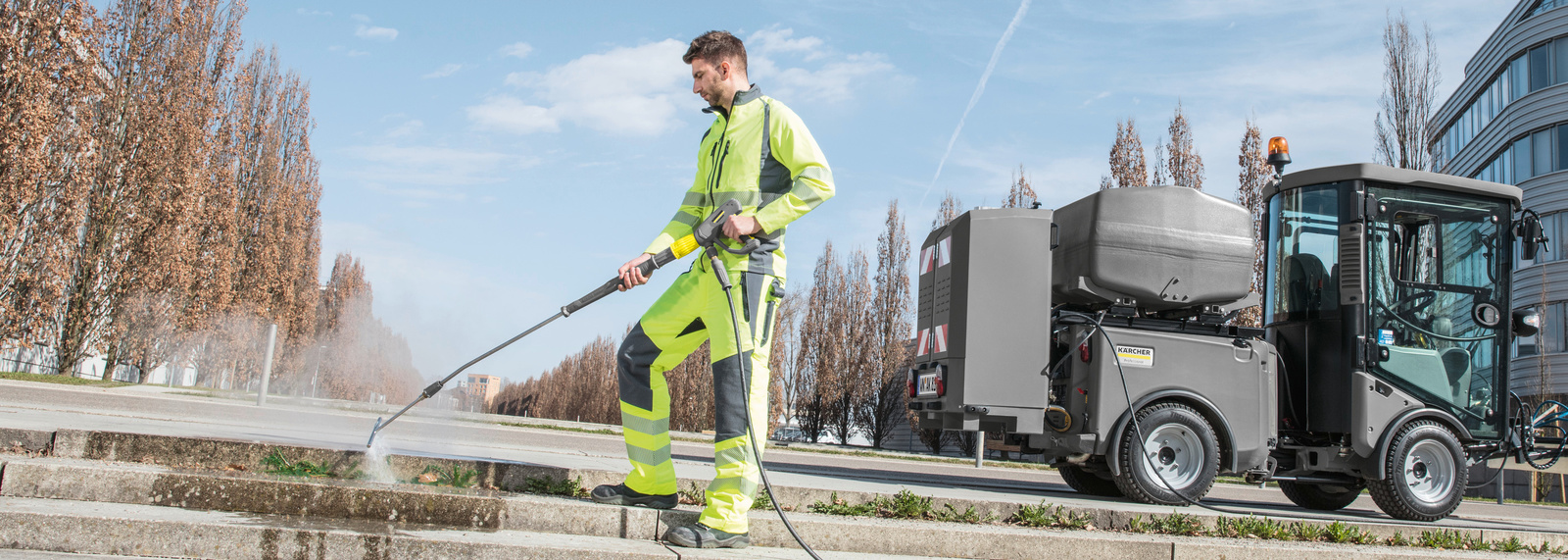Cleaning car parks, paths and outside areas
Whether visiting a restaurant, shopping in a supermarket, furniture store or shopping centre, or visiting a doctor or museum – often the first thing guests do on arrival is to park their car and make a short walk to a building. There are a number of methods to make a positive impression right from the start, to prevent the risk of accidents and to stop dirt being brought in from outside.

Sweeping outside areas – removing loose dirt
Dust and loose dirt should be removed from the car park and foyer using either push vacuum sweepers or ride-on equipment, depending on the size of the space. The vacuum function prevents dirt from being kicked up and, where applicable, deposited on parked cars or furniture such as benches.
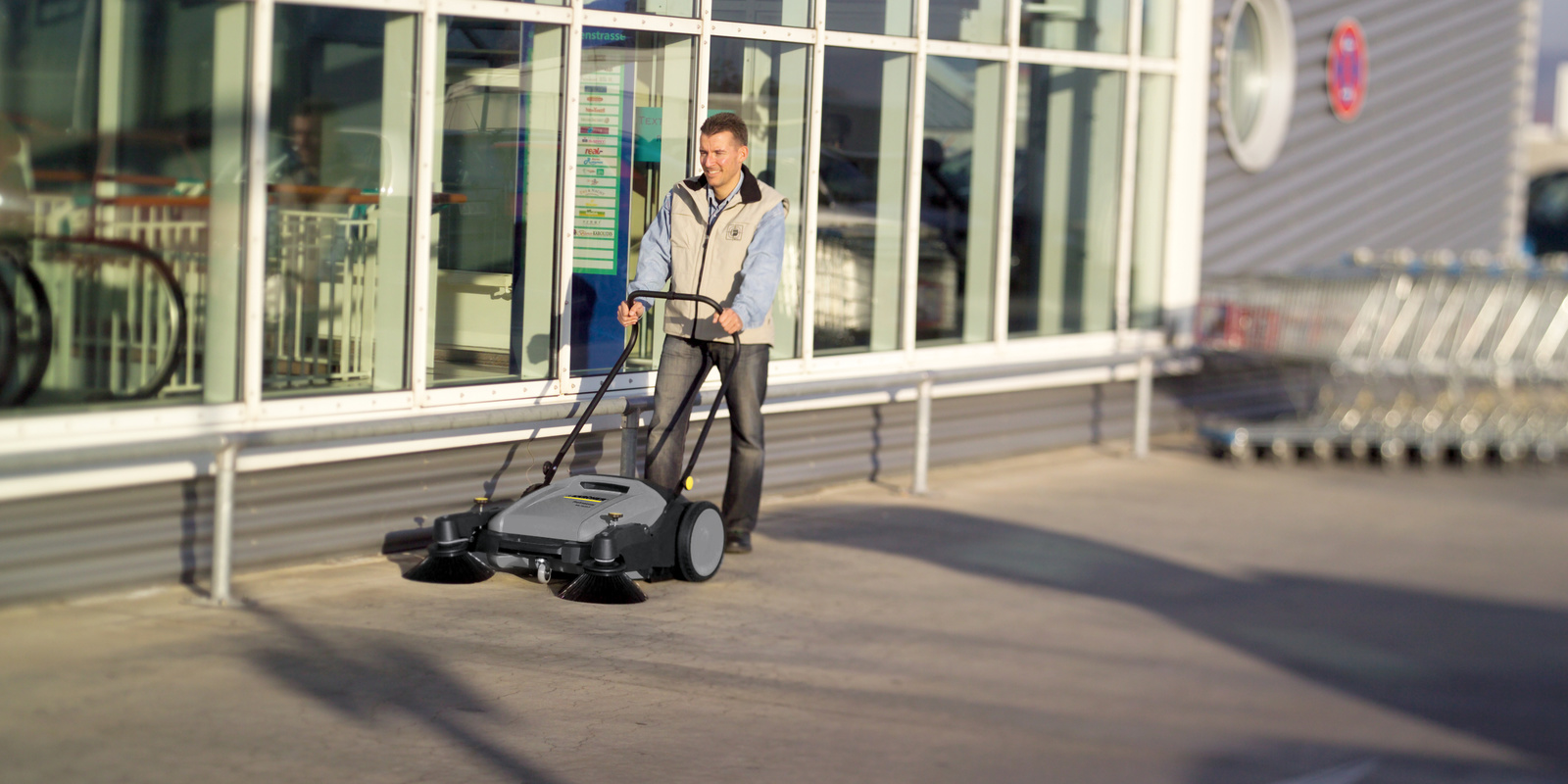
For smaller areas of up to 300 square metres, push sweepers with a dirt capacity of up to 42 litres are used.
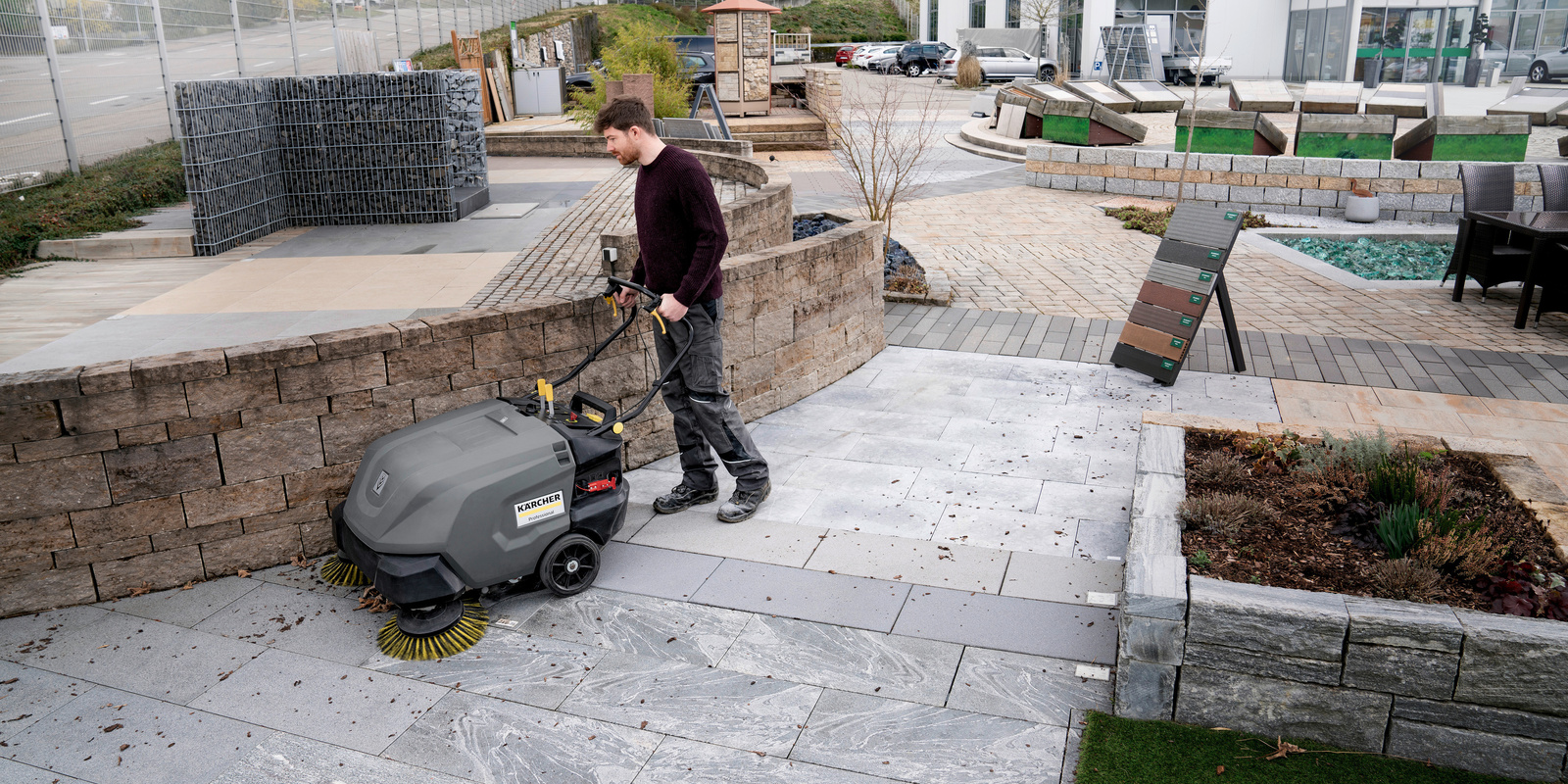
For medium-sized areas of up to 1000 square metres, use push vacuum sweepers with a traction drive and an extraction system with a filter system, among other features.
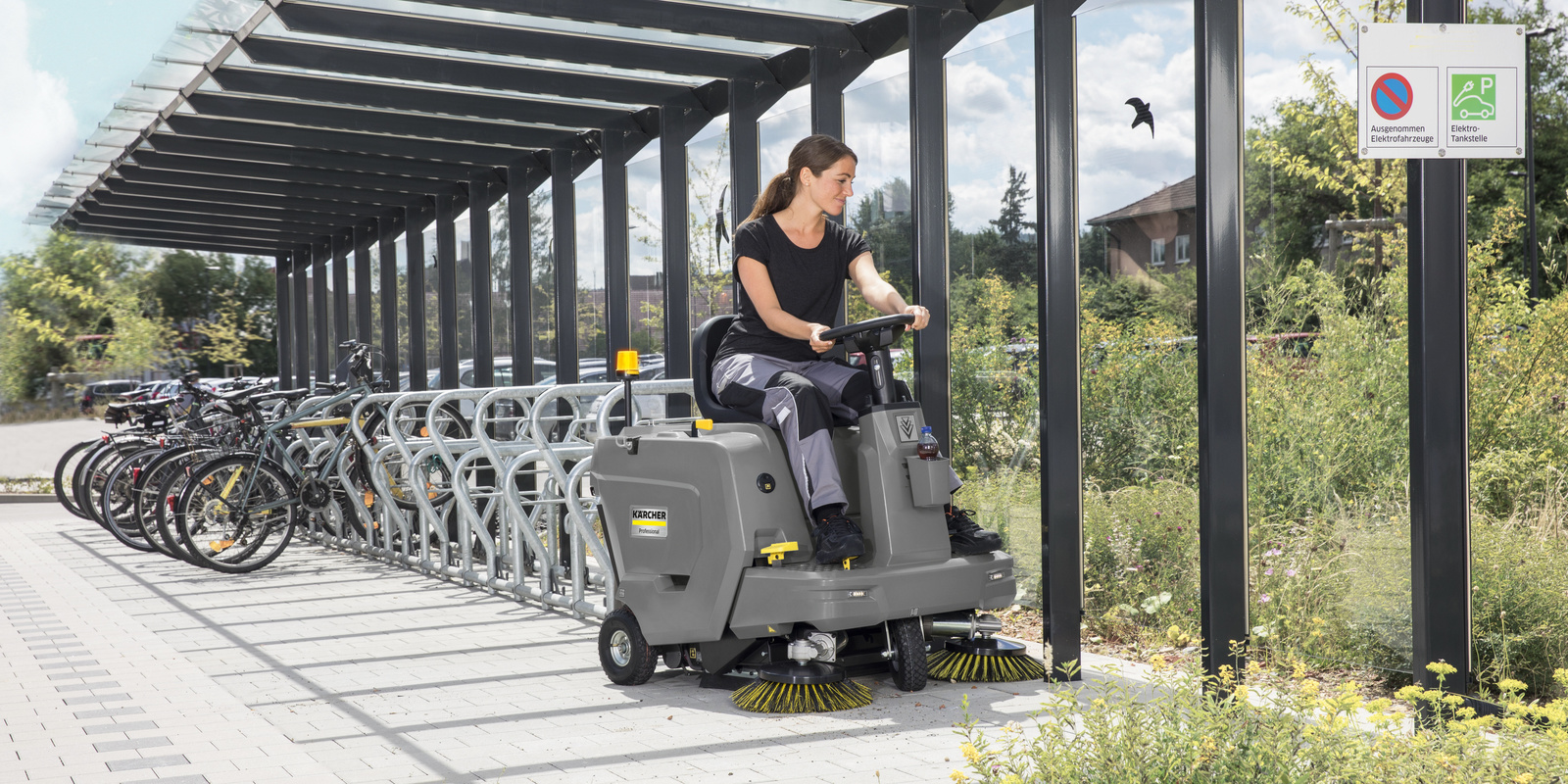
For bigger areas spanning 1500 square metres and more, use ride-on vacuum sweepers. These have a large container volume and some of them come with hydraulic high container emptying. For very large car parks, municipal vacuum sweepers are also an alternative.
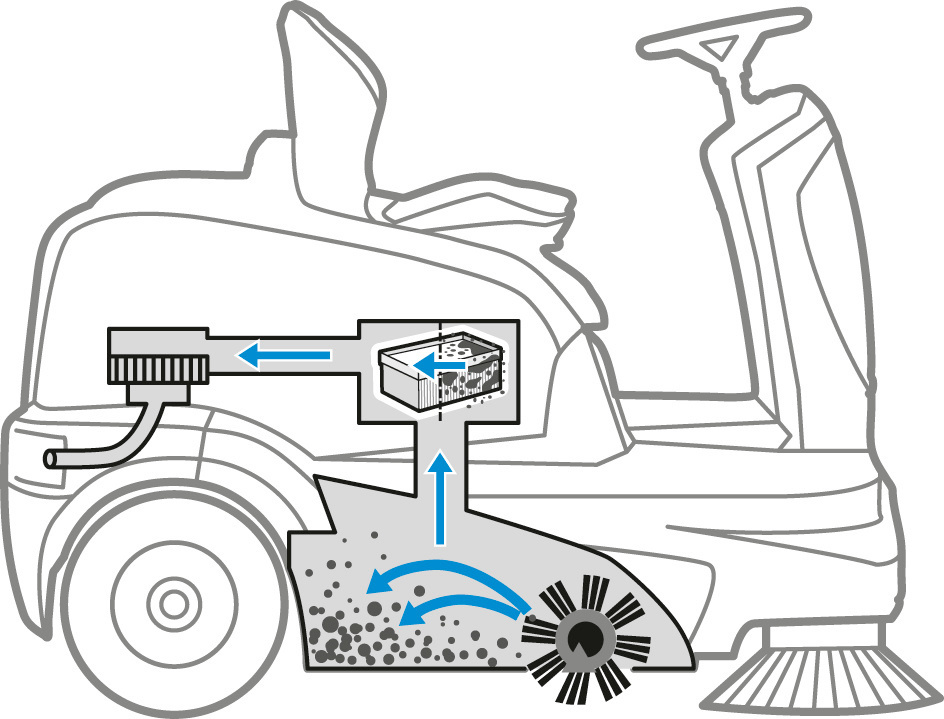
The classic ride-on sweeper
As with all other tasks, not all sweeping is the same. The choice of machine and accessories is based on the surface, type of dirt and size of the area or distances to be covered. The classic ride-on sweeper tends to be used for a fixed range of applications, i.e. for individual objects such as car parks or outside areas around multi-purpose halls. Moreover, the machine's side brush means that it is suitable for sweeping edges and corners. The collected road dirt is then picked up by the main sweeper roller. Moreover, the sweeper can reach working speeds of up to 14 km/h, enabling work to be completed quickly and effectively.
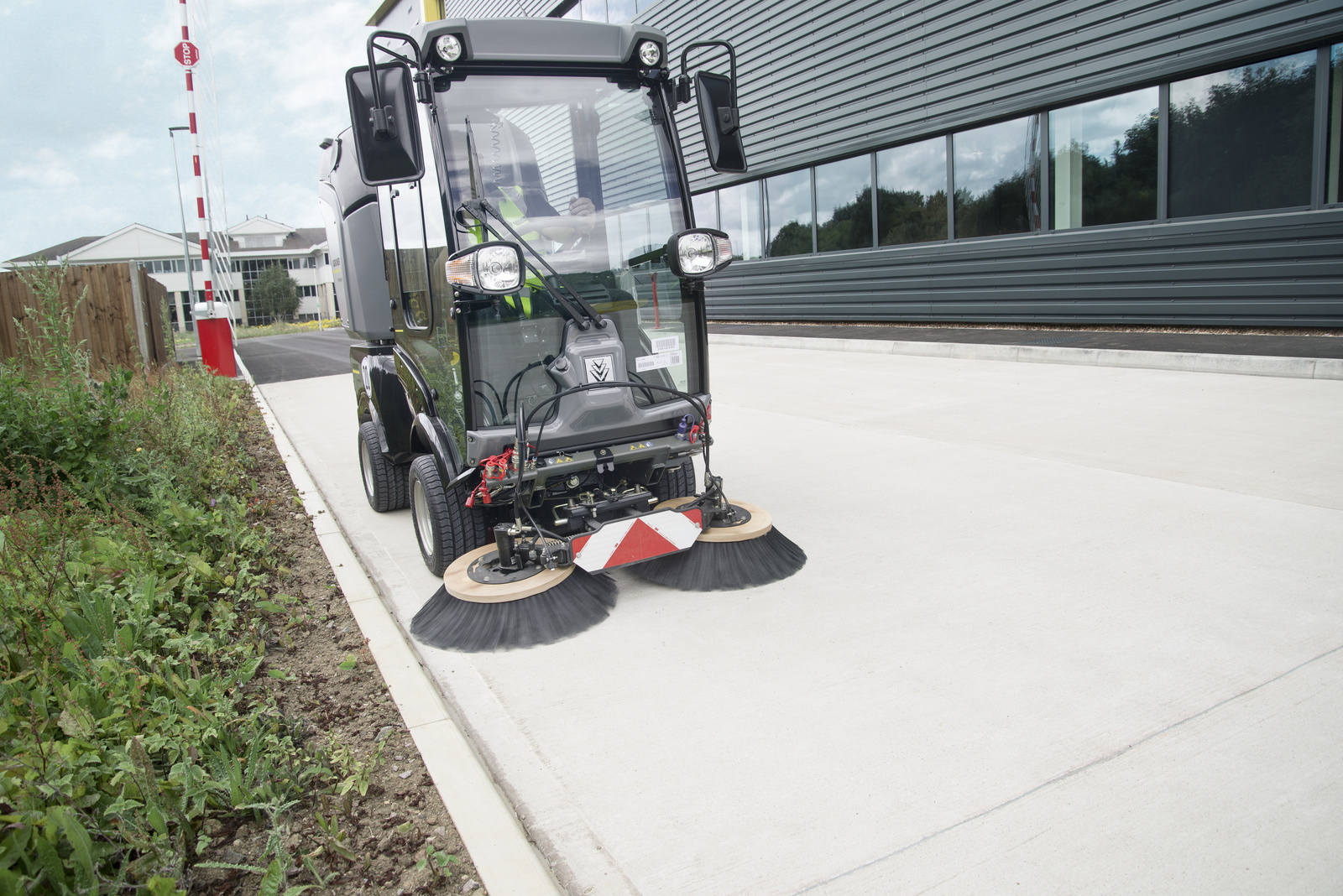
Municipal and vacuum sweepers
Whether machines are battery-powered or powered by liquid gas, petrol or diesel must be decided according to the area of application. For instance, smaller areas can also be cleaned using battery-powered machines. However, for example, their limited climbing ability makes them less suitable, or even unsuitable, for steeper ascents. Municipal and vacuum sweepers use their side brushes to sweep up dirt, which is then vacuumed up through the suction mouth. These machines can be used to quickly clean larger areas and are also able to tackle extended sections of roads, reaching speeds of up to 40 km/h. In addition, municipal machines can be used year-round since the cab offers driver comfort with features like air-conditioning, among others.
From the sweeper's accessories to its filter
Using the right roller brush is vital when it comes to the quality of the sweeping. Harder roller brushes pick up larger and heavier dirt more effectively and are also suitable for use in damp conditions or on very rough floor coverings. On the other hand, soft roller brushes are more suitable for larger quantities of fine dust or light debris because they stir up less dust during operation. We particularly recommend using a soft roller brush on smooth and delicate floor coverings. In addition, it's not just the main sweeper roller which has bristles of varying hardness, this is also true of the side brushes, which have the same properties.
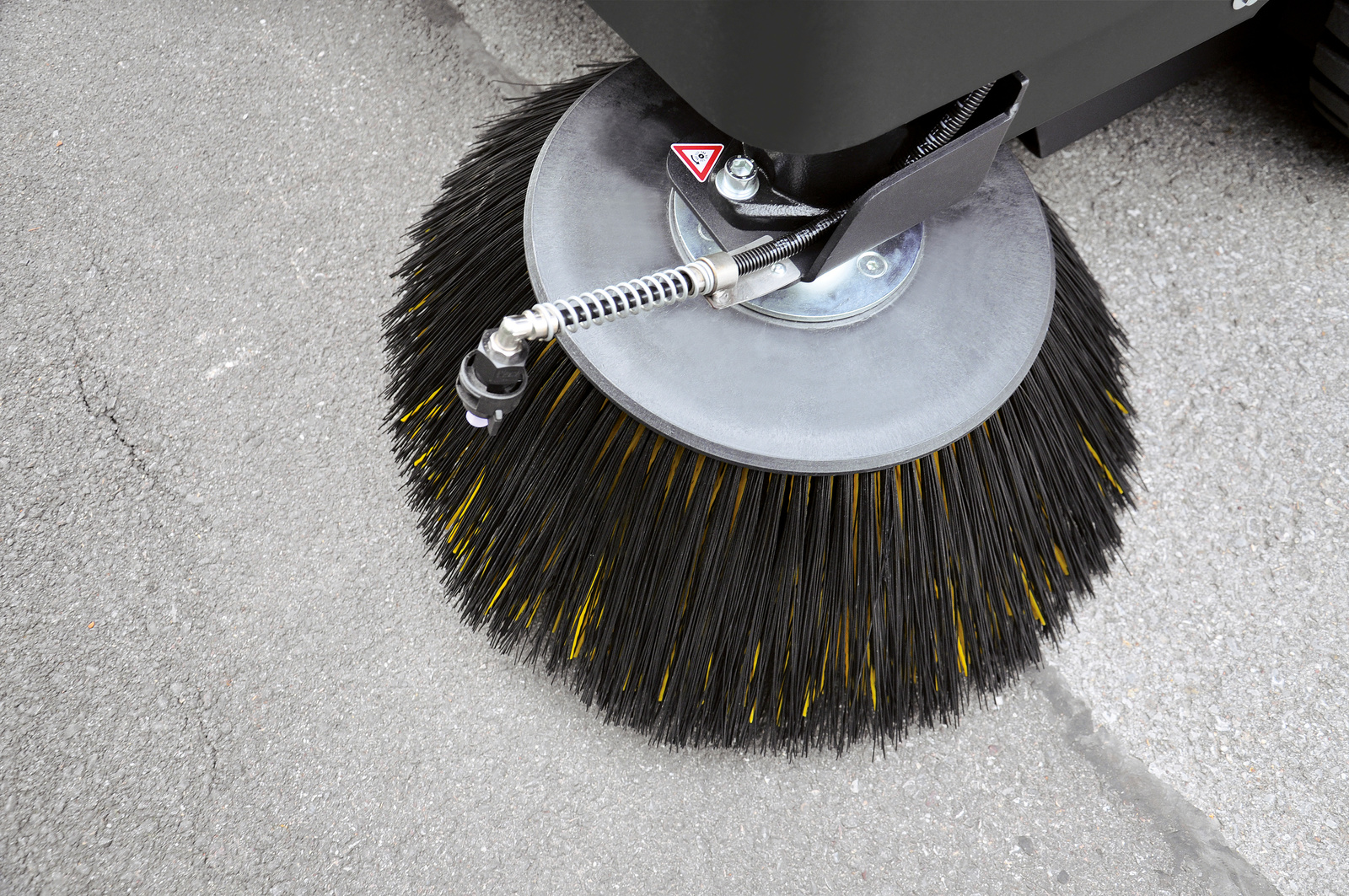
There are also multiple methods for preventing dust from being kicked up in how the sweepers are used.
On particularly dry, dusty surfaces, it is advisable to deactivate the side brushes and to only work with the main sweeper roller. If it is not possible to deactivate the side brushes, another way of considerably reducing the amount of dust stirred up is simply to reduce the working speed. In addition, depending on the machine, you can bind or reduce the dust by fitting attachment kits such as a water spraying system, side brush cover or speed regulation for the side brush.
What people often don't realise is that vacuum sweepers can still be used when it is raining, without the moisture damaging the filter for exhaust air cleaning.
In dry air conditions, this filter ensures that fewer fine dust particles escape into the surrounding area. When it is raining, you can either switch off the fan or guide the exhaust air around the filter using a bypass. The rain binds the dust and this does not cause any problems for the exhaust air.
Wet cleaning of outside areas
There are a multitude of options for wet cleaning, including washing at low, medium and high-pressure, scrubbing with brush technology and hot-water cleaning. Again, it is important to outline the most common application scenarios. Should this technique be used for daily cleaning of paths or is it better suited to removing oily dirt? Which method is suitable for which application and are there times where it's better to contact a service provider?
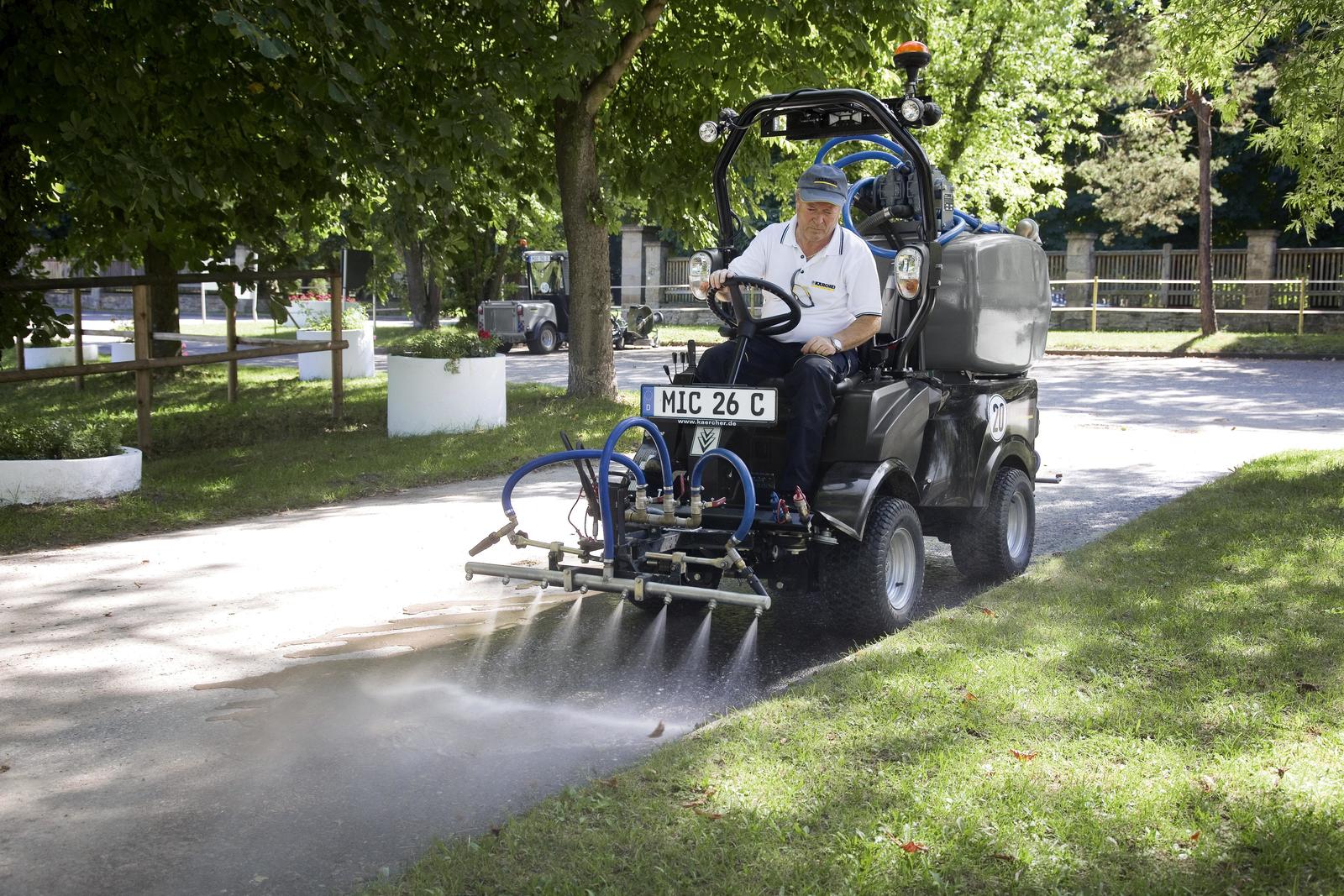
Washing: The required result determines the pressure used
Municipal machines with a washing bar are often used for washing applications, while manually operated machines like high-pressure cleaners are also another option. In any case, it is always important to select the right nozzles and to adjust the pressure to the intended requirements. For coarse cleaning, a low pressure of up to 12 bar is usually used. This allows you to bind large amounts of dust or to rinse off muddy roads after a storm. The available solutions are relatively inexpensive but do require a lot of water and sufficiently large tanks.
Medium-pressure washing is an option for versatile use. It has been found that pressures of up to 40 bar are particularly suitable for maintenance cleaning on roads and pavements. However, it is not possible to carry out thorough, fibre-deep cleaning because the water pressure is too low.
High-pressure washing is often used for particularly tough cleaning tasks, such as intensive cleaning after a street party. The water penetrates deep into the pores of the surfaces at up to 250 bar and rinses them clean. Moreover, less water is consumed than during low and medium-pressure washing.
Highly effective and versatile: Scrubbing with disc brush technology
Wet cleaning with brush technology is becoming more and more popular in outside areas as the requirements for this type of cleaning grow. In some cases, it is even a question of protecting high-quality road surfaces from deteriorating and maintaining them as sustainably as possible.
While either disc or roller brushes are used for interior cleaning, disc brushes are usually used for exterior cleaning. They boast reduced wear and tear, a high area performance and also operate at a low rotational speed with low contact pressure. In addition, you can also use cleaning agents and to remove the dirty water in order to achieve the best possible cleaning result.
Thanks to their manoeuvrability, transport speed, ground clearance and the all-wheel drive available on some machines, municipal machines offer considerable advantages in inner-city areas with respect to their flexibility, quick availability and wide range of applications compared to larger machines designed for industrial use.
Anyone who has their wits about them when purchasing machinery will look for a provider whose machines are versatile and can be used all-year round. The models should be able to sweep and wet-clean, as well as quickly switch between different implements. This allows you to schedule using scrubbing and sweeping units alternately in order to achieve the desired result, depending on the requirements for cleanliness.
If, in special cases, it is necessary to use cleaning agents, it's worth contacting the application engineer or technical advisor at the manufacturer to establish the right combination of brushes and cleaning agents to be used according to the condition of the floor and the level of dirt.
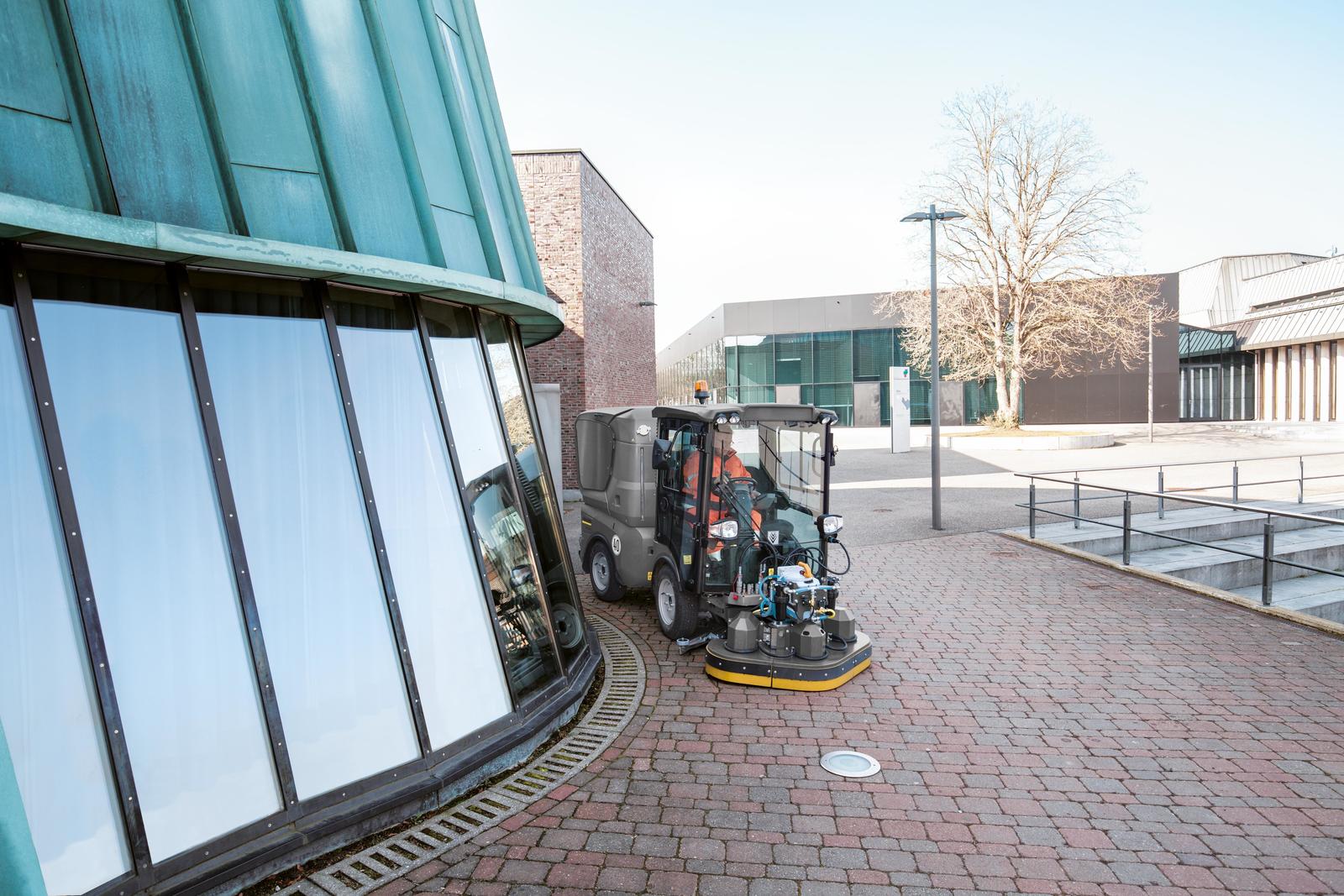
For particularly tough cleaning tasks: Hot-water cleaning
Manual cleaning with hot-water high-pressure cleaners is suitable for a range of surfaces and for removing different types of dirt. This includes, for example, effectively removing organic discolouration/growth or weeds, dirt caused by emissions, as well as leftover food and drink or their stains.
If you need a high area performance for cleaning floors, for example, you should not only consider the working pressure but, most importantly of all, the flow volume of the machine when choosing a suitable model. A surface cleaner is an ideal special accessory and may also remove the dirty water, depending on the model.
Moreover, the sweeper's versatility and range of applications can be improved thanks to the choice of machine type. For example, there are hot-water high-pressure cleaners available with an electric motor or a combustion engine. There are also smaller, mobile machines, as well as trailer solutions. In this case, the trailer machines have diesel or petrol engines and sufficiently large water tanks, which allow users to work independently for up to over an hour, depending on the machine.
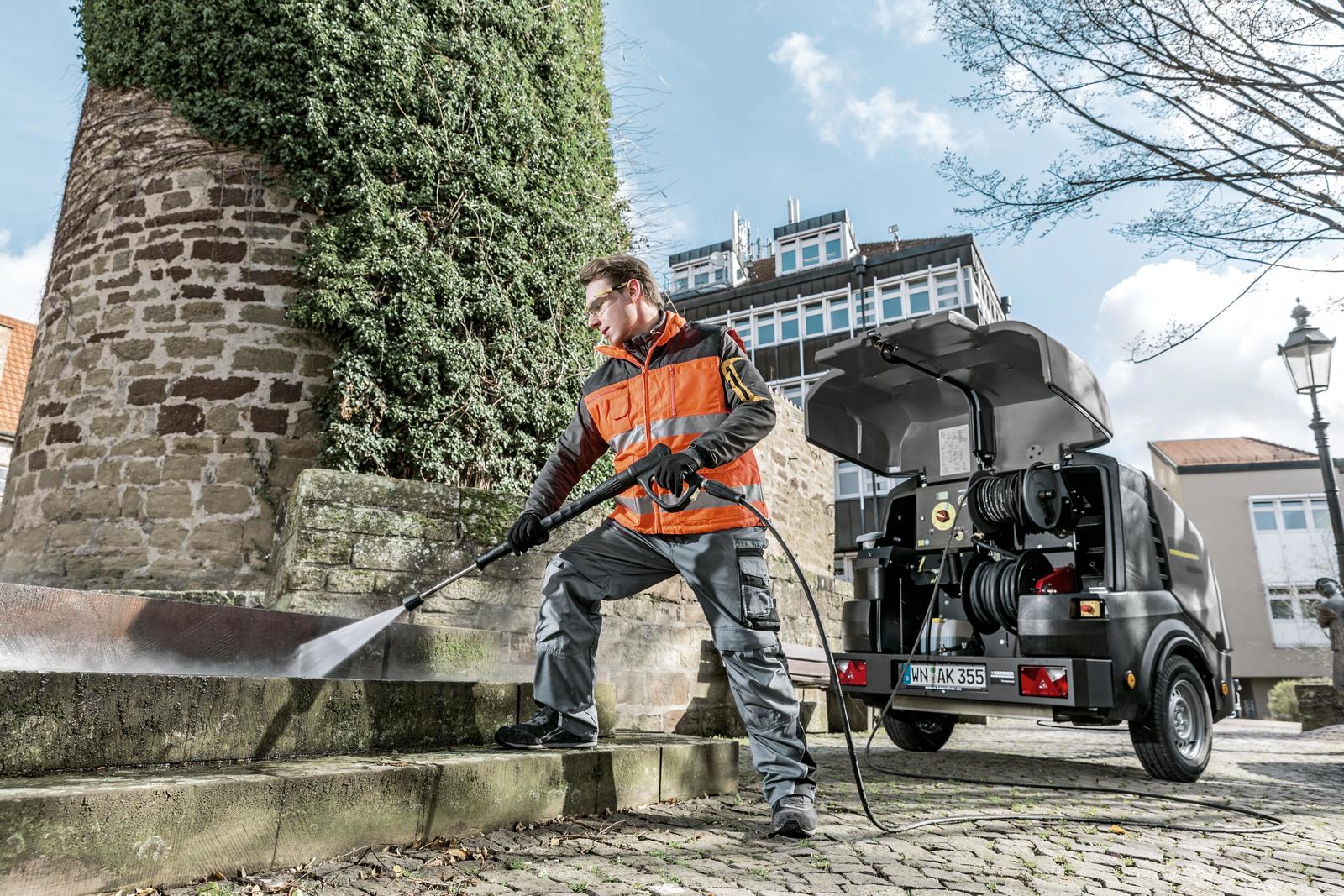
Safety first: What users should look out for
It is vital that the various cleaning techniques are applied correctly in order to prevent accidents at work. It is therefore important to know the risks. These include:
- For washing applications, using a low pressure (up to 12 bar) is non-critical; while at medium (up to 40 bar) and high pressures (up to 250 bar and above), body contact must be avoided because the high pressures may cause tissue damage.
- When sweeping and scrubbing, caution should be exercised when handling brushes. Appropriate protective clothing must be worn as the brushes can cause cuts, depending on their hardness.
- If cleaning agents are used, the safety precautions will vary depending on the concentrate, pH value and surfactants. However, in all cases, you must always put water into the container before adding the cleaning agent and ensure that suitable personal protective equipment is worn when handling the relevant cleaning agents. This prevents pure concentrate from splashing upwards and causing physical contact and possible injury.
Weed removal
Depending on the subsoil, weeds can spread to a varying degree in public places, on footpaths or in car parks. While hardly any weeds can penetrate through sealed asphalt surfaces, paved areas are much more acutely affected.
If you want to prevent weeds from spreading, you should remove the fertile ground for these unwanted guests. Weeds grow from pollen settling in dust and dirt and then sprouting as dandelions, thistles, etc. Regular sweeping is the most effective way of keeping weeds under control. Sweeping also means that the surfaces are well-maintained and there is reduced fine dust pollution. However, the necessary operational capacity has high requirements in terms of personnel and machinery.
Methods for effectively removing existing weed growth include using hot air, hot water, water steam and a weed brush, depending on the degree of growth. These methods are applied, for example, using suitable hot-water high-pressure cleaners or with municipal machines in combination with appropriate implements. In addition, the grasses' natural growth curve should be noted so that work can be carried out at the right time.
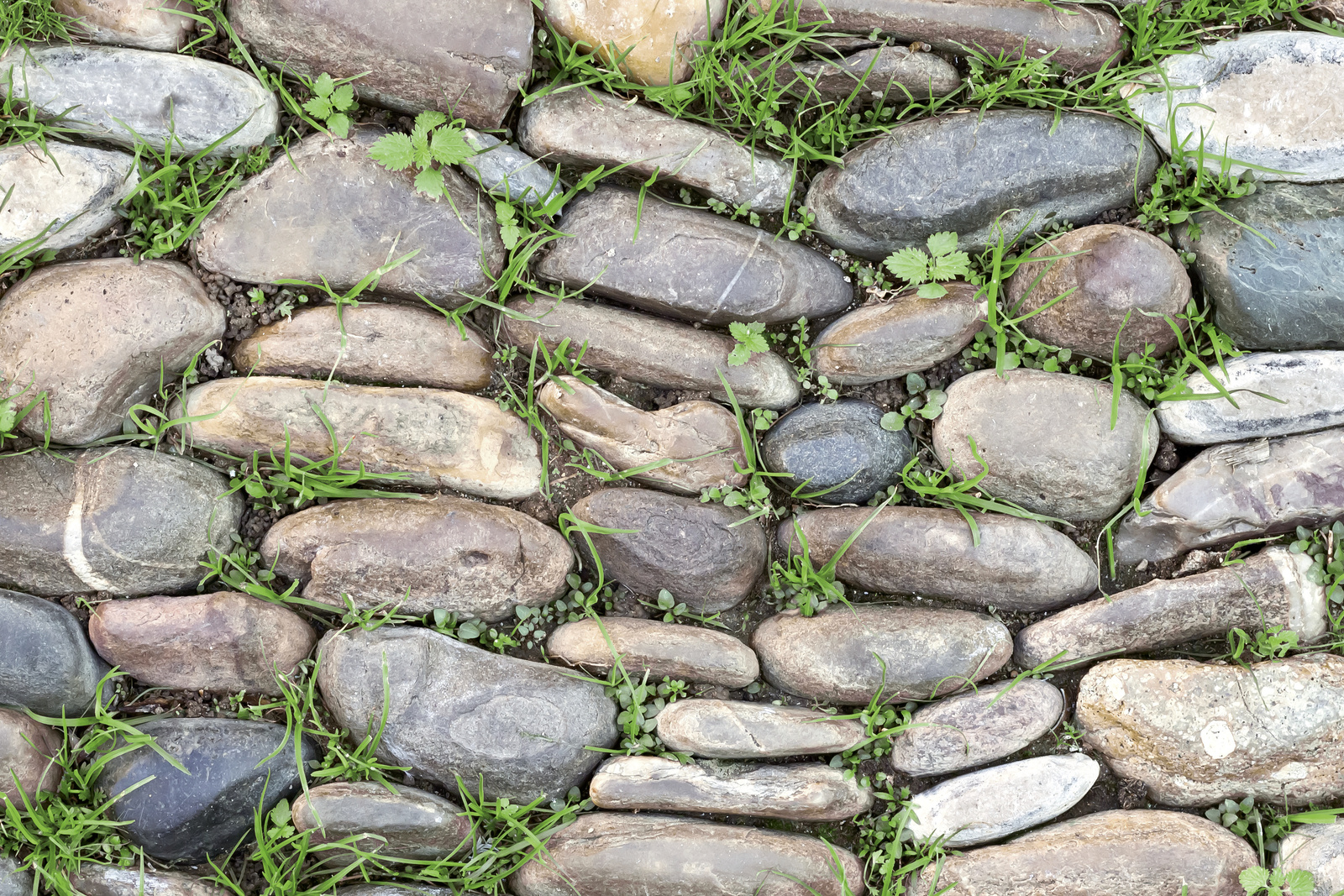
Removing weeds
Tackling weeds effectively is a major challenge. Chemical products are available, but they are often harmful to the environment and can only be used in a limited way in public spaces. Dandelions, thistles, etc. can be removed totally using hot water and without herbicides – a procedure that protects the environment as well as surfaces.

